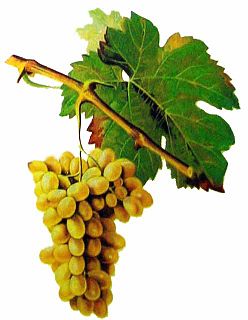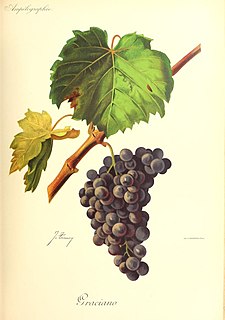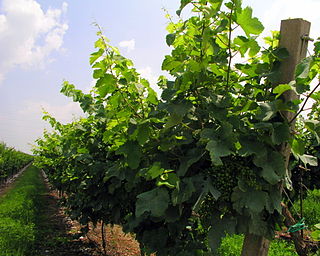Related Research Articles

Dolcetto is a black Italian wine grape variety widely grown in the Piedmont region of northwest Italy. The Italian word dolcetto means "little sweet one", but it is not certain that the name originally carried any reference to the grape’s sugar levels: it is possible that it derives from the name of the hills where the vine is cultivated. In any case the wines produced are nearly always dry. They can be tannic and fruity with moderate, or decidedly low, levels of acidity and are typically meant to be consumed within a few years after release.

Aglianico is a black grape grown in the southern regions of Italy, mostly Basilicata and Campania. It is considered with Sangiovese and Nebbiolo to be one of the three greatest Italian varieties. Aglianico is sometimes called "The Barolo of the South" due to its ability to produce highly refined, complex fine wines like the famous Piedmont wine, Barolo.

Clairette blanche is a white wine grape variety most widely grown in the wine regions of Provence, Rhône and Languedoc in France. At the end of the 1990s, there were 3,000 hectares of Clairette blanche grown in France, although volumes are decreasing.

Vermentino is a light-skinned wine grape variety, primarily found in Italian wine. It is widely planted in both in Sardinia and Liguria, to some extent in Corsica, in Piedmont under the name Favorita, and in increasing amounts in Languedoc-Roussillon. The leaves are dark green and pentagonal. The grapes are amber-yellow and hang in pyramidal bunches. The vines are often grown on slopes facing the sea where they can benefit from the additional reflected light. The Vitis International Variety Catalogue now gives Italy as its origin.

Canaiolo is a red Italian wine grape grown through Central Italy but is most noted in Tuscany. Other regions with plantings of Canaiolo include Lazio, Marche and Sardegna. In Umbria a white berried mutation known as Canaiolo bianco exists. Together with Sangiovese and Colorino it is often used to create Chianti wine and is an important but secondary component of Vino Nobile di Montepulciano. In the history of Chianti it has been a key component blend and during the 18th century may have been the primarily grape used in higher percentage than Sangiovese. Part of its popularity may have been the grape's ability to partially dry out without rotting for use in the governo method of prolonging fermentation. In the 19th century, the Chianti recipe of Bettino Ricasoli called for Canaiolo to play a supporting role to Sangiovese, adding fruitiness and softening tannins without detracting from the wine's aromas. In the aftermath of the phylloxera epidemic, the Canaiolo vines did not take well to grafting onto new American rootstock and the grape began to steadily fall out of favor. As of 2006, total plantings of Canaiolo throughout Italy dropped to under 7,410 acres. Today there are renewed efforts by Tuscan winemakers to find better clonal selections and re-introduce the variety into popular usage.

Montepulciano is a red Italian wine grape variety that is most noted for being the primary grape behind the DOCG wines Offida Rosso, Montepulciano d'Abruzzo, Montepulciano d'Abruzzo Colline Teramane, Rosso Conero and the DOC wine Rosso Piceno Superiore.

Graciano is a Spanish red wine grape that is grown primarily in Rioja. The vine produces a low yield that are normally harvested in late October. The wine produced is characterized by its deep red color, strong aroma and ability to age well. Graciano thrives in warm, arid climates.
Albillo or Albillo Real is a white Spanish wine grape variety planted primarily in the Ribera del Duero region, and also in Madrid, Ávila and Galicia. The grape has mostly neutral flavors with a light perfume aroma. It has a high glycerol index which confers smoothness to the wines.
Erbaluce or Erbaluce bianca is a white Italian wine grape grown primarily in the Piedmont region around Caluso, in Canavese. In addition to dry table wines, it is used to make sweet wines with deep golden coloring, such as passito. The grape has a long history in the Piedmont region, with the first written record dating to 1606, and most likely originated in the alpine hills of northern Piedmont.
Mammolo is a red Italian wine grape that is planted primarily in Tuscany. While its use has been diminishing, Mammolo was historically included in the blended Sangiovese-based wines of Chianti where it contributed a distinctive violet or mammole aroma. In addition to small plantings in the Chianti zone, Mammolo can be found in the Vino Nobile di Montepulciano region of Tuscany and in scattered vineyards throughout Central Italy.
Uva Rara is a red Italian wine grape variety that is grown in the Piedmont and Lombardy wine regions of northern Italy. The grape is a permitted blending variety along with Nebbiolo in the Denominazione di Origine Controllata e Garantita (DOCG) wines of Ghemme. In the Denominazione di Origine Controllata (DOC) wine region of Oltrepò Pavese the grape is often blended with Barbera and Croatina. While Uva Rara's name means "rare grape" in Italian, the variety is actually widely planted with 608 hectares of the vine recorded in Italy in 2000.

Falanghina, also called Falanghina Greco, is a variety of wine grape, Vitis vinifera, used for white wines. It is an ancient grape variety which may have provided a basis for the classical Falernian wine, and has considerable character. It is cultivated on the coast of Campania north of Naples, and frequently consumed in southern Italy along with seafood. The name for the wine appears to derive from the Latin falangae, or stakes for supporting the grapes in a vineyard. In November 2014 Falanghina was approved as a recognized varietal by the Alcohol and Tobacco Tax and Trade Bureau for use in the United States.

Glera, also known as Prosecco, is a white variety of grape of Slovenian origin, which was brought to the village of Prosecco from the Karst region. The variety was formerly mostly referred to as Prosecco, but in the EU was renamed "Glera" in 2009 to make room for the protection of "Prosecco" as the name of a geographically-protected wine.
Fortana is a red Italian wine grape variety grown primarily in the Emilia–Romagna region of northern Italy. A permitted grape variety in several Denominazione di origine controllatas (DOCs), mostly in Emilia, Fortana mostly contributes tartness and acidity in red blends.
Listán Prieto is a red grape variety that is believed to be originated from the Castilla-La Mancha region in Spain. Listán Prieto has disappeared from Spain mainland, but there are still 29 ha planted on the Canary Islands in 2008.

Pecorino is a white Italian wine grape variety that grows in the Marche, Abruzzo, Tuscany, Umbria and Lazio regions of Italy. Ampelographers believe that the grape is likely native to Marche, where the soil destined for this cultivation increases every year. This grape variety is used to produce the DOCG wines, like the Offida Pecorino DOCG, and the DOC wines, like the Falerio dei Colli Ascolani, the Colli Maceratesi and the Falerio dei Colli Ascolani.
Mantonico bianco is a white Italian wine grape variety that is grown in the Calabria region of southern Italy. Ampelographers believe that the grape is likely of Greek origins and was transported to southern Italy by ancient Greek settlers. Though the variety has a long history in Calabria, its numbers have been slowly declining with 1100 hectares/2700 acres planted in the region by the end of the 20th century.

Luglienga is a white Italian wine and table grape variety that is grown across Europe. The grape has a long history of use, dating back to at least the 14th century in Piedmont but is today most seen a table grape that is occasionally used for home winemaking.
Alionza is a white Italian wine grape variety that is grown in the Emilia-Romagna region of north central Italy, where it has a long history of being used since the 14th century as both a table grape and blending grape for wine production. While sometimes confused with the Greek wine grape Sklava, DNA analysis in the early 21st century has suggested, instead, that Alionza may be closely related to the Tuscan wine grape Trebbiano.
Bonamico is a red Italian wine grape variety that is grown in the province of Pisa in Tuscany where the grape has a reputation for producing very high yields. Some ampelographers speculate that the grape may have originated around the town of Palaia with the grape being known under the synonym of Uva di Palaia. While often used as a table grape, Bonamico can be a minor blending component in several Tuscan Denominazione di Origine Controllata (DOC) and Indicazione Geografica Tipica (IGT) wines where it often contributes floral aroma notes and acidity.
References
- ↑ Robinson, Jancis, ed. (1999). "Pelaverga". The Oxford Companion to Wine (2nd ed.). winepros.com.au. Archived from the original on 2012-03-14.
- 1 2 "Pelaverga". Vitis International Variety Catalogue . Archived from the original on 2012-01-20. Retrieved 2010-11-09.